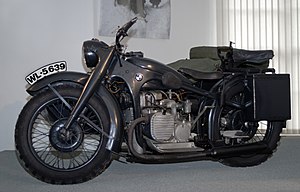Hello ladies and gents this is the viking telling you that today we are talking about

BMW R12

It’s weird that over the last few decades BMW has become so well known for its oddball front suspension arrangements, because back in the 1930s it was a pioneer of what are now considered conventional telescopic forks. The R12 and R17 of 1936 both used oil-damped teles, which is why they’re included on this list instead of some of the earlier machines (like Scotts) that had undamped telescopic forks. Given that, despite endless efforts to come up with something better, the telescopic fork simply refuses to go away, BMW could be seen as prescient in adopting them so early.
The BMW R12 is a pre-World War II motorcycle that was produced by the German company BMW. The motorbike was first presented and developed in 1935.[3] A total of 36,000 motorcycles were built by 1942.
History
On 14 February 1935, BMW presented the R12 together with the BMW R17 on the German Automobile Exhibition in Berlin for the first time, being a direct successor to the BMW R11. This and the R17 were the first in the world being produced with hydraulically damped telescopic forks. By 1942, the total number of BMW R12 motorcycles manufactured was 36,000. For military purposes, the Einvergasermotor was only available for the R12.
Description
Engine
The engine, designated M 56 S 6 or 212, was a twin-cylinder boxer configuration - four stroke with a flathead design. The BMW R12 with two carburetors used a battery and coil ignition, while R12s with a single carburetor used a magneto ignition, capable of working independently from the battery.
Drive
The BMW R12 had a four-speed manual gearbox, operated by a hand shift lever on the fuel tank's right side. Several detail variations were seen in production. In common with most BMW Motorcycles, final drive was via shaft, with the drive shaft on the right side of the motorcycle.
Suspension and brakes
Front suspension used a telescopic fork, while the frame was rigid with an un-sprung rear end supporting the final drive and a sprung seat for the rider. The R12 used drum brakes front and rear. Many R12's were equipped with a sidecar attached to the motorcycle's right side.
And as always have a chilled day from the viking as a final question who likes BMW motorbikes?
Comments
Post a Comment